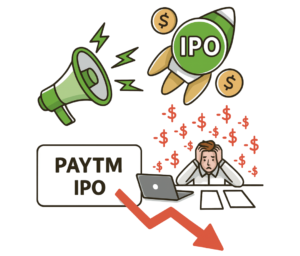
Introduction
The stock market is a place where logic often takes a back seat to emotion. Despite endless advice from financial experts about buying low and holding long-term, retail investors routinely do the opposite. We chase the frenzy of Initial Public Offerings (IPOs) and run away when markets correct. This behavioral contradiction is what I call The Investor’s Paradox—and it’s costing investors dearly.
The IPO Illusion: FOMO Dressed as Opportunity
Every time a major IPO is announced, especially a tech unicorn or consumer brand, the media buzz creates an illusion of a once-in-a-lifetime opportunity. Retail investors, driven by the fear of missing out (FOMO), scramble to get a piece—even if the company has no profits or uncertain fundamentals.

Let’s take the example of Paytm’s IPO in 2021. Despite expert warnings about its overvaluation, the IPO was oversubscribed. Within weeks, the stock tanked, wiping out significant wealth. This isn’t an isolated case. Numerous IPOs debut at high valuations, only to see reality catch up post-listing.
Why does this happen? It’s behavioral finance at play. The herd mentality and recency bias trick our minds into believing that listing gains are guaranteed. Unfortunately, IPOs are often priced for perfection, leaving little room for upside.
Market Dips: Discounts Disguised as Danger
Now contrast this with how investors behave during market corrections. When the Nifty 50 drops by 10% or more, panic spreads. News headlines scream “bloodbath,” and WhatsApp forwards predict market crashes. Retail investors rush to redeem mutual funds, sell quality stocks, or stop SIPs—essentially exiting when prices are more favorable.
This behavior is again rooted in emotion, not logic. Loss aversion—the psychological tendency to feel the pain of losses more intensely than the pleasure of gains—leads to irrational decision-making. When valuations are attractive and future returns are likely to be better, investors are ironically least interested.
A quick look at history shows that every market dip has been a wealth-building opportunity. Whether it was the 2008 crash, the 2020 COVID dip, or the correction in 2022, those who stayed invested or bought more reaped the rewards.
The Expert View: Flip the Script
As a financial expert, I see this paradox repeated across portfolios, age groups, and geographies. Here’s what rational investing should look like:
- Avoid IPO hype: Unless you understand the business and valuation thoroughly, treat IPOs as speculative plays, not investment opportunities.
- Buy during dips: Corrections are not crises. They are entry points. Systematic Investment Plans (SIPs), lump-sum investments during dips, or even rebalancing can significantly boost long-term returns.
- Turn off the noise: The media thrives on panic. Market cycles are natural. Your strategy should be immune to headlines.
- Focus on intrinsic value: Follow Warren Buffett’s mantra: “Be fearful when others are greedy, and greedy when others are fearful.”
Conclusion: Mastering the Paradox
The investor’s paradox is real, but it can be conquered. Understand that your emotions are the biggest risk to your wealth, not the market. Building wealth is less about finding the next big IPO and more about disciplined investing during unpopular times.

